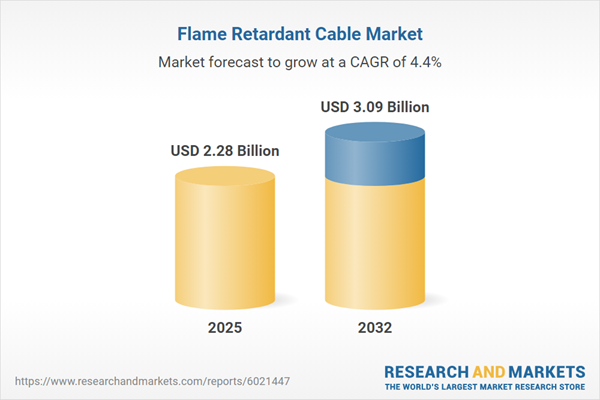Speak directly to the analyst to clarify any post sales queries you may have.
Flame retardant cable solutions are fundamental for senior leaders aiming to enhance safety, ensure compliance, and future-proof their infrastructure investments. As regulatory landscapes and operational risks evolve, strategic cable choices contribute directly to organizational resilience and sustained asset value.
Market Snapshot: Flame Retardant Cable Market Outlook and Core Drivers
The flame retardant cable market is in a steady growth phase, expanding from USD 2.19 billion in 2024 to USD 2.28 billion in 2025 and projected to reach USD 3.09 billion by 2032, achieving a CAGR of 4.40%. This expansion is primarily driven by increasing urbanization and significant investments in advanced, robust power infrastructure. Regulatory agencies are intensifying fire safety requirements, which has elevated market activity across sectors such as transportation, petrochemicals, and data centers. Organizations across public and private domains regard advanced flame retardant cable solutions as integral for risk mitigation and reliable long-term system performance, ensuring greater resilience in mission-critical applications.
Scope & Segmentation: Strategic Coverage for Executive Planning
- Cable Types: Includes coaxial, control, data, fiber optic, and power cables—each designed to address technical demands ranging from high-speed communications to industrial controls and reliable power transfer in diverse environments.
- Applications: Sectors such as automotive, construction, marine, offshore, oil and gas, and electrical transmission each present distinctive fire exposure risks, requiring tailored cable solutions that meet stringent safety specifications.
- Insulation Materials: Options consist of LSZH (Low Smoke Zero Halogen), PE, PVC, and XLPE, balancing emission reduction, environmental benchmarks, and ongoing cost management for installations across industries.
- Voltage Classes: Product offerings cover high, medium, and low voltage, enabling compatibility from utility-scale grids to industrial machinery and commercial building systems for reliable energy delivery.
- Conductor Materials: Aluminum and copper are selected based on attributes such as conductivity, efficiency, and lifecycle economics, allowing project alignment with performance and budget goals.
- Installation Environments: Designed to fit varied settings, these solutions address requirements for both protected indoor applications—such as data center raceways—and demanding outdoor environments, including offshore and marine exposures.
- Sales Channels: Distribution comprises direct sales, collaborations with industry distributors, and online procurement, ensuring supply agility for structured projects and sudden replacement needs alike.
- Regional Coverage: The market encompasses the Americas, EMEA (Europe, Middle East, Africa), and Asia-Pacific, with each region adapting to varying regulatory environments, infrastructure investment priorities, and adoption speeds.
- Featured Companies: Leading companies such as Prysmian S.p.A., Nexans S.A., NKT A/S, LS Cable & System Ltd., Southwire Company LLC, Sumitomo Electric Industries Ltd., Polycab India Limited, Furukawa Electric Co., Ltd., LEONI AG, and Taihan Electric Wire Co., Ltd. are advancing global reliability standards and technological innovation.
Key Takeaways: Strategic Insights for Senior Leadership
- Regulators and insurers now require flame retardant cables as foundational to operational risk management, raising compliance criteria across industrial sectors.
- Growing implementation of halogen-free insulation, particularly LSZH, underscores the emphasis on environmentally responsible fire mitigation and reduced toxic emissions.
- Integration of intelligent cable technologies—including fiber optic sensing and real-time temperature monitoring—enables proactive risk response and maintenance in high-value environments.
- Sustainability priorities are reflected in increased demand for recyclable insulation options and energy-conscious cable production processes, supporting organizational environmental commitments.
- Distinct industry concerns shape product choices; for example, the automotive and offshore segments require compact, flexible designs, while grid operators focus heavily on reliability under continual operational stress.
Tariff Impact: Navigating Supply Chain Changes
Recent U.S. trade tariffs have prompted cable manufacturers to shift procurement and sourcing strategies. The move toward localized production and diversified supplier networks is helping organizations maintain stability and supply chain resilience. Leadership teams that proactively adapt sourcing and collaborate with suppliers can sustain operational continuity and minimize exposure to market disruptions.
Methodology & Data Sources
This analysis leverages comprehensive technical reviews, in-depth evaluations of regulatory and intellectual property trends, and targeted industry expert interviews. Data validity is ensured by referencing market databases and authoritative international trade records, providing stakeholders with reliable market insights aligned to current realities.
Why This Report Matters
- Supports executive and procurement teams with actionable insights to inform investments in compliant, adaptable flame retardant cable solutions.
- Recommends approaches for aligning R&D, strategic partnerships, and procurement with sector-specific safety and technology shifts.
- Prepares organizations to proactively address regulatory trends and operational risks, strengthening infrastructure resilience for the long term.
Conclusion
Flame retardant cable market intelligence is essential for resilient infrastructure strategy. Responsive adoption of emerging technologies and regulatory standards underpins secure, sustainable industry growth and organizational stability.
Additional Product Information:
- Purchase of this report includes 1 year online access with quarterly updates.
- This report can be updated on request. Please contact our Customer Experience team using the Ask a Question widget on our website.
Table of Contents
3. Executive Summary
4. Market Overview
7. Cumulative Impact of Artificial Intelligence 2025
Companies Mentioned
The companies profiled in this Flame Retardant Cable market report include:- Prysmian S.p.A.
- Nexans S.A.
- NKT A/S
- LS Cable & System Ltd.
- Southwire Company, LLC
- Sumitomo Electric Industries, Ltd.
- Polycab India Limited
- Furukawa Electric Co., Ltd.
- LEONI AG
- Taihan Electric Wire Co., Ltd.
Table Information
| Report Attribute | Details |
|---|---|
| No. of Pages | 181 |
| Published | October 2025 |
| Forecast Period | 2025 - 2032 |
| Estimated Market Value ( USD | $ 2.28 Billion |
| Forecasted Market Value ( USD | $ 3.09 Billion |
| Compound Annual Growth Rate | 4.4% |
| Regions Covered | Global |
| No. of Companies Mentioned | 11 |









